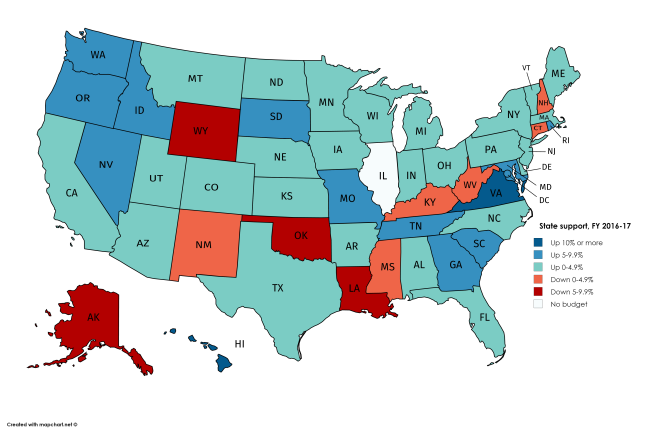You have /5 articles left.
Sign up for a free account or log in.

State funding for higher education changes varied by state in 2016-17, with most states reporting increases.
Data: Grapevine
State support for higher education is rising moderately this fiscal year, with more than three-quarters of states posting increases on the way to countrywide percentage growth in the low single digits.
Support across all states rose by 3.4 percent from the 2015-16 to 2016-17 fiscal years, according to preliminary data gathered in the latest Grapevine survey, which was released today. That’s an increase of approximately $2.75 billion, driving total state support to nearly $83.6 billion.
“We had a modest increase across most states,” said James Palmer, a professor of higher education at Illinois State University and Grapevine editor. “It’s an indication, I think, that there’s a willingness across states to fund and increase funding for higher ed.”
The broad trend does not match much faster rates of increase seen before the financial crisis of a decade ago, Palmer said. But it does reflect a shift from the widespread cutbacks that states carried out in the lean years after the financial crisis.
Even though the broad trend was upward, funding levels played out differently in individual states. Most notably, Illinois remains mired in a multiyear budget standoff that has drastically affected public funding for higher education. Lawmakers have put only makeshift funding in place for the current fiscal year after allocating stopgap funding last year. Last year’s stopgap funding for higher ed in Illinois, roughly $817 million, was the equivalent of just 17 percent of funding that had been allocated in the last year Illinois had a full budget, the 2014-15 fiscal year, according to Palmer. Stopgap monies allocated so far for the current fiscal year, $1.4 billion, are higher but still only equal to 29 percent of 2014-15 levels.
The situation in Illinois is still evolving, so more money could be on the way for the current fiscal year. But the last two years have been unsettled enough -- and unusual enough -- that the Grapevine report also breaks out across-the-board funding changes for the 49 states other than Illinois. Across those states, state funding rose 2.7 percent this year to $82.2 billion.
Signs of the financial strain are showing at Illinois universities. Those that lack nonstate resources have been particularly hard hit, such as Chicago State University, which last year declared financial exigency and later controversially parted ways with its president after only nine months. Observers at the time wondered about the university’s ability to survive, pointing out that its cafeteria had been closed for weeks and its library had limited hours.
The large University of Illinois System has also been affected, prompting leaders there to support a proposed deal that would limit tuition and increase emphasis on in-state students in exchange for predictable funding over five years.
“I think this is unprecedented in the history of the Grapevine project,” Palmer said, noting the project goes back to the 1960s. “I think the Illinois situation is an anomaly. The fact that we haven’t had a full state budget for two years is indicative of the fiscal impasse that the state finds itself in.”
When last year’s Grapevine report was released, Illinois wasn’t the only state without a budget. Pennsylvania hadn’t finalized one, either. But Pennsylvania has since broken its budget stalemate, leaving Illinois standing alone as its budget impasse drags on through its second year.
The more than three-quarters of states -- 39 in total -- that posted increases in higher education funding in 2016-17 raised it by significantly different amounts. The smallest increase was 0.2 percent in Colorado and Wisconsin. The largest was 10.5 percent in Hawaii.
Meanwhile, 10 states reported decreasing funding: Alaska, Connecticut, Kentucky, Louisiana, Mississippi, New Hampshire, New Mexico, Oklahoma, West Virginia and Wyoming. West Virginia was home to the smallest decrease, 0.4 percent. Wyoming had the biggest decrease, 8.8 percent.
This year the survey also measured higher education funding from Puerto Rico and Washington, D.C., for the first time. In Puerto Rico funding rose by 0.2 percent. Funding in D.C. rose by 6.6 percent.
Changes in state funding were significantly less varied than they were last year, when increases ranged from 0.1 percent in Kentucky to 16.2 percent in Oregon and decreases ranged from 0.1 percent in New Jersey to 14 percent in Arizona.
Over all last year, the Grapevine report found 39 states increasing state funding and nine reporting decreases. Countrywide state support for higher education rose 4.1 percent between 2014-15 and 2015-16, it found.
Many of the states experiencing declines in funding this year are energy-rich states that depend on taxes or fees tied in some way to the oil and gas industry, Palmer said. The oil and gas sector has been struggling amid low prices recently.
“That’s an indication of the extent to which funding for higher education is in part dependent on the capacity of states,” Palmer said. “When tax revenue within the states goes down, capacity to fund higher education goes down, and we tend to see decreases in funding for higher education.”
Louisiana is one such state with a large energy industry and a drop in state funding this year. State funding for higher education dropped 7.2 percent in 2016-17, the third-largest drop in the Grapevine report. But the state of the oil industry is only part of the story behind the funding drop, according to Joseph Rallo, commissioner of higher education in Louisiana.
State statute and the Louisiana Constitution protect nearly all areas of state spending, he said. Some health care spending and higher education are virtually all that are left unprotected, so they are cut when state revenues fall short.
“As the income stream has gone down -- not just because of the revenue from oil or minerals, but across the board from jobs or income tax -- they have to balance the budget,” Rallo said. “It’s simply that we’re unprotected.”
Public higher education in Louisiana is preparing for a round of midyear cuts. Legislators are attempting to find ways to close a budget hole of more than $300 million. State funding has already been cut sharply in recent years, including other rounds of midyear cuts in the past.
Different institutions will handle cuts in different ways. But they have real impacts for students, Rallo said.
“Tuition has gone up, sadly,” he said. “We’re being told for next year, the budget woes are even worse.”
South Dakota was on the other side of the spectrum, with the third-highest percentage increase in state support, 9.3 percent year over year. No single factor drove the increase, said Michael G. Rush, executive director of the state's Board of Regents.
Technical institutes received a special appropriation to make instructor salaries competitive. Universities received a bump in funding for salaries, and the state provided money for a "tuition buy-down," offering funding that normally would have come from tuition.
The prospects for future increases in the state are unclear, though. South Dakota is not an energy-heavy state, but its budget is looking tight for the upcoming year. Agriculture is a large driver, and some low commodity prices have driven down sales tax revenue, Rush said.
"It doesn't look very rosy," he said. "I hope we don't lose ground."
The Grapevine report released Monday also includes two- and five-year comparisons for a better look at funding trends over time. Looking back two years and comparing fiscal 2014-15 budgets with 2016-17 budgets, 40 of 49 states posted increases. The smallest increase came in Mississippi, 0.4 percent. The largest increase was in Oregon, 21.5 percent. Nine states reported a decrease. The smallest decrease was in Kentucky, 0.4 percent. The largest decrease was in Oklahoma, 18.7 percent.
Comparing this year with 2011-12 -- a year when higher education received federal stimulus money -- 42 of 49 states posted five-year increases. Those increases ranged from 2.1 percent in Arizona to 51.4 percent in New Hampshire. Seven states experienced decreases ranging from 1.8 percent in both Arkansas and Kansas to 17.8 percent in Oklahoma.
The Grapevine data are intended to provide a tentative early look at the state of higher education funding. It’s collected annually as part of a project between the Center for the Study of Education Policy at Illinois State and the State Higher Education Executive Officers Association. The Grapevine data precede the release of an annual SHEEO report that provides a more in-depth examination of state higher education support and includes factors like inflation and enrollment.
Grapevine data include tax and nontax support for operations and other higher ed activities but do not measure other sources of college and university revenue, like tuition.
Percent Change in State Appropriations
| State | Total Support, 2016-17 (dollars) | 1-Year Change | 5-Year Change, Including Stimulus Funds |
|---|---|---|---|
| Alabama | 1,562,306,106 | 4.5% | 4.5% |
| Alaska | 335,851,000 | -6.9% | -6.7% |
| Arizona | 842,010,200 | 4.7% | 2.1% |
| Arkansas | 999,831,300 | 1.1% | -1.8% |
| California | 13,579,469,229 | 2.5% | 48.5% |
| Colorado | 866,808,182 | 0.2% | 34.4% |
| Connecticut | 1,154,757,551 | -4.1% | 21.6% |
| Delaware | 234,722,700 | 2.1% | 10.1% |
| Florida | 4,578,325,642 | 4.8% | 26.4% |
| Georgia | 3,203,141,388 | 5.2% | 18.2% |
| Hawaii | 667,478,019 | 10.5% | 27.8% |
| Idaho | 460,323,000 | 9.9% | 38.0% |
| Illinois* | 1,408,803,500 | -- | -- |
| Indiana | 1,760,033,532 | 0.3% | 13.4% |
| Iowa | 855,409,017 | 0.7% | 15.5% |
| Kansas | 769,175,109 | 0.3% | -1.8% |
| Kentucky | 1,170,767,200 | -0.5% | -5.2% |
| Louisiana | 1,094,801,855 | -7.2% | -11.5% |
| Maine | 299,575,645 | 4.8% | 10.6% |
| Maryland | 1,964,463,400 | 5.5% | 22.3% |
| Massachusetts | 1,544,319,564 | 3.4% | 27.8% |
| Michigan | 1,877,039,600 | 2.8% | 21.1% |
| Minnesota | 1,543,313,000 | 0.7% | 20.1% |
| Mississippi | 1,013,678,408 | -2.4% | 6.2% |
| Missouri | 1,089,159,140 | 5.2% | 16.7% |
| Montana | 253,311,859 | 1.6% | 25.3% |
| Nebraska | 773,101,444 | 3.4% | 18.9% |
| Nevada | 570,958,220 | 6.0% | 20.7% |
| New Hampshire | 125,200,059 | -2.1% | 51.4% |
| New Jersey | 2,083,569,000 | 0.7% | 4.3% |
| New Mexico | 861,383,002 | -4.8% | 7.0% |
| New York | 5,765,073,288 | 2.8% | 18.8% |
| North Carolina | 3,978,682,420 | 3.9% | 11.2% |
| North Dakota | 419,650,340 | 3.4% | 22.0% |
| Ohio | 2,303,647,976 | 3.5% | 14.4% |
| Oklahoma | 857,022,108 | -7.6% | -17.8% |
| Oregon | 814,589,131 | 5.0% | 43.9% |
| Pennsylvania | 1,693,108,000 | 2.8% | 3.3% |
| Rhode Island | 188,214,286 | 5.3% | 4.1% |
| South Carolina | 1,094,964,380 | 6.7% | 27.4% |
| South Dakota | 238,612,300 | 9.3% | 31.8% |
| Tennessee | 1,732,289,377 | 5.6% | 22.4% |
| Texas | 7,600,210,799 | 2.5% | 17.6% |
| Utah | 978,663,600 | 4.9% | 34.3% |
| Vermont | 92,326,259 | 1.7% | 2.5% |
| Virginia | 2,054,183,184 | 10.3% | 26.5% |
| Washington | 1,878,116,000 | 6.1% | 37.9% |
| West Virginia | 484,109,152 | -0.4% | -10.9% |
| Wisconsin | 1,473,947,300 | 0.2% | 33.1% |
| Wyoming | 382,164,128 | -8.8% | 13.1% |
| Total, 50 states | 83,572,660,899 | 3.4% | 16.2% |
| Total 49 states without Illinois | 82,163,857,399 | 2.7% | 20.2% |
*Illinois lawmakers did not pass a budget for the last two fiscal years. Listed dollar totals are stopgap funding for higher education.








